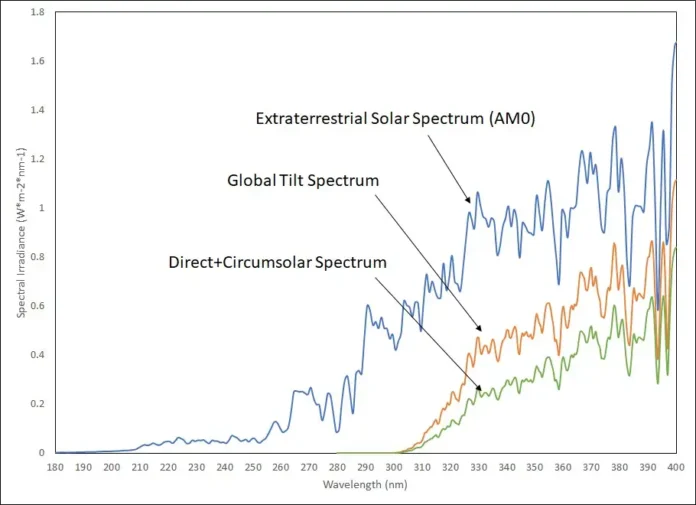By Ryan Sawyer, Andrew Brzezinski, Stephen Walker and Heather MacGillivray, Sciencetech, Inc.
In space, UV light exposure can degrade materials on spacecraft and compromise their integrity over time through photochemical reactions. Knowledge of the effects of UV exposure on materials is necessary for the design of all spacecraft, from the ISS to CubeSats. During the recent COVID-19 pandemic, results from solar simulation studies highlighted the importance of UV light in inactivating the SARS-CoV-2 virus.
One method to study these interactions is by using solar simulators. Solar simulators can be designed to reproduce the extraterrestrial or terrestrial solar spectrum to a close approximation. Simulators can be designed to provide the crucial UV component of the solar spectrum, allowing researchers to conduct experiments in photochemistry, photobiology, space material degradation, material characterization and many other applications where UV light plays an important role.
Introduction
Solar simulation technology continues to evolve, from the first simulators developed for use by NASA to simulators that use light emitting diode (LED) technology to specialized simulators that produce concentrated high flux or a high degree of collimation to ones that use flash or pulsed sources (Wang and Laumert, 2014). Solar simulators primarily are used to test photovoltaics, but they also are useful tools for a diverse array of disciplines. Scientists use solar simulators to investigate photodegradation of spacecraft components and material coatings under long exposure to UV radiation consistent with extraterrestrial environments. These tests can take the form of accelerated age tests where samples are subjected to UV irradiance multiple times more intense than normal sunlight. Recently, solar simulators have been used to study the effects of solar UV radiation on the SARS-CoV-2 virus.
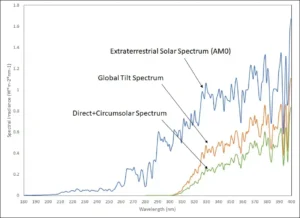
Xenon short arc lamps are well suited for use in UV solar simulators due to their continuous spectrum that emits from the UV to the visible and IR regions. Xenon lamp emission is similar to a 6000 K blackbody and has a spectrum similar to the extraterrestrial solar spectrum in the UV and visible wavelengths. Filters often are used to shape the xenon spectrum for desired qualities, such as a closer spectral match to sunlight in space or sunlight on the surface of Earth at various latitudes and accounting for atmospheric absorbance. Unfiltered xenon is useful in extraterrestrial photodegradation studies because the spectrum in the UV-VIS is similar to the extraterrestrial solar spectrum, and it is more cost effective because it does not require the use of expensive custom filters.
Solar simulators often are used for characterizing photovoltaic materials. They are particularly useful for applications that require 1 sun irradiance (1,000 W/m2 on earth or 1,367 W/m2 in earth orbit). Larger solar simulators with a basic design that can be customized for unique purposes are useful for applications with special requirements, vacuum chambers, where multiple suns irradiance are required or where laboratory space is constrained. The authors’ company has produced solar simulators which have been adapted to confined laboratory spaces, attached to vacuum chambers, used for super collimated sunlight, and attached to glove boxes and concentrated to the equivalent of 12 suns of spatially uniform irradiance.
Standards
Standards are used to evaluate the performance of solar simulators. Common standard bodies include ASTM, IEC, JIS and ISO. Solar simulators are evaluated for their spectral match, spatial non-uniformity and temporal instability and are graded as Class A, B, C or U (IEC 60904-9:2020 also includes a Class A+). The standards are evolving, as embodied in standards for spectral coverage (IEC 60904-9:2020 only) and spectral deviation (IEC 60904-9:2020 only), which ensure that LEDs, and other sources apart from Xenon lamps, provide a representative spectrum. Such standards mainly are applicable to the testing and characterization of photovoltaics; however, the qualities mentioned above may be desired in one combination or another for different use cases. It also should be noted that qualities such as collimation are not represented in any standard, nor does any standard apply to irradiance values different than 1 sun.
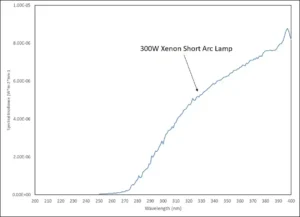
For space studies, ASTM E490 provides the extraterrestrial, or AM0 (air mass 0), solar spectrum. ASTM E927-19 describes how to evaluate solar simulators for terrestrial and space applications. ASTM G177 is a standard that references the solar ultraviolet spectral irradiance and is used to evaluate light sources for laboratory weathering and exposure studies. Figure 1 compares the extraterrestrial solar spectrum with the terrestrial solar spectrum from the ASTM G173-03 standard. An unfiltered xenon spectrum is presented in Figure 2.
Simulator Design and Laboratory Safety
Solar simulator design for UV applications poses a number of challenges. Optical components must be made of UV-fused silica and mirrors must be coated in a UV-enhancing material. Ozone production from wavelengths shorter than ~240 nm must be adequately managed due to health and safety risks. Filters must be specially designed so as not to absorb the crucial UV component of the spectrum. In some instances, unfiltered xenon provides the best compromise because of the cost associated with developing custom filters. By far, the biggest challenge is preserving UV-C radiation along the beamline to the sample. UV-C reacts with air to produce ozone and, in the process, is absorbed. Typically, one would use a nitrogen environment with the ability to purge as a way of preserving the UV-C component. However, xenon lamps require significant cooling during operation due to the intense level of light generated. The best and most economical way of cooling a solar simulator is through forced-air cooling with fans. These challenges must be overcome in order to build an effective UV solar simulator.
In a laboratory environment, the production of ozone through the interaction of UV radiation below 250 nm and air poses a health hazard for personnel. Solar simulators using xenon lamps typically use lamps with envelopes made of fused quartz doped with various metals to block transmission of wavelengths below 250 nm. In applications where UV radiation <250 nm is needed, the lamp envelope is made of ultra-pure fused silica to fully transmit emission from the xenon arc. Design and manufacturing considerations need to be made to mitigate the build-up of ozone in an enclosed environment. Common solutions involve adding exhaust ports to the housings of simulators to extract ozone into a building’s HVAC system or remove it from the building through a window. There also are “ozone eater” devices on the market that can attach to simulators and destroy ozone. Ozone alarms also can be used effectively. They can be affixed to the simulator or a point nearby and wired to the power supply in such a way that when the alarm is tripped, the simulator shuts down.
Space Studies
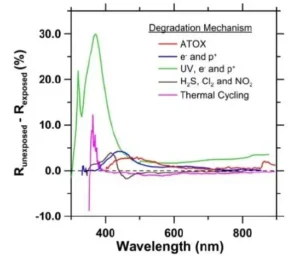
UV radiation below ~300 nm is blocked by Earth’s atmosphere, whereas objects in space receive the full spectrum of solar radiation. The ASTM E490 standard shows the solar spectrum at air mass zero, or the extraterrestrial solar spectrum. Materials exposed to a broad range of UV light from the UV-C to the UV-A can undergo degradation. Dever et al. (2005) highlight some of the negative effects of UV exposure on polymers and ceramic materials. Synthetic polymers and the contaminants contained within them (a byproduct of the manufacturing process) absorb solar UV radiation. This absorption causes photochemical reactions that negatively affect the mechanical properties of the materials. Garoli et al. (2020) note that the UV photons themselves do not contribute to degradation processes but that they promote oxidation and reduction reactions which change material composition and properties. Figure 3 (reproduced from Figure 1b of Garoli et al. (2020)) shows a number of different degradation mechanisms, including UV radiation, and their effects on the reflectivity of protected silver mirrors.
Glass and ceramic materials can be darkened through the process of solarization, where color centers – holes filled by trapped chemical species that absorb specific wavelengths of light – can form. In addition to affecting white paint coatings and glass coverings, such darkening processes can affect optical components on space telescopes (Dever et al. 2005; Garoli et al. 2020). Tarrio et al. (2023) found that UV radiation interacting with water vapor (a possible contaminant) can create oxide layers on filters similar to those used in spacecraft instruments. The development of such layers leads to transmission losses.
Solar simulators using xenon arc lamps often are used to test the strength of materials for spaceflight and to understand the effects caused by UV exposure (Garoli et al. 2020). Indeed, such simulators can be designed to use high-powered lamps (>3 kW) in order to provide multiple suns worth of irradiance on target for accelerated age testing. Such simulators can be used with vacuum chambers, either coupled or uncoupled, to better simulate a space environment. It is difficult to reproduce a space environment in terms of the vacuum UV (100 to 200 nm) and near UV (200 to 400 nm) (Miller and Banks, 2010). Solar simulators can be designed to produce near UV wavelengths – with some difficulty achieving wavelengths less than 250 nm – but physical, practical and cost limitations exist that restrict the ability of simulators to operate below that range.
COVID-19 Research
UV-C light is commonly used as a sterilization technique due to its ability to neutralize germs and inhibit virus growth, but its use is limited due to atmospheric absorption (Nicastro et al. 2021). During the recent COVID-19 pandemic, much research was done on the effects of UV-B and UV-A on the SARS-CoV-2 virus (e.g., Ratnesar-Shumate et al. 2020; Schuit et al. 2020; Nicastro et al. 2021; Raiteux et al. 2021; Wondrak et al. 2021). However, Bernhard et al. (2023) state that many of these studies that used solar simulators do not adequately describe the simulator specifications.
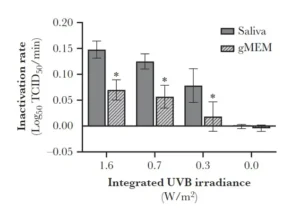
Ratnesar-Shumate et al. (2020) studied the effects of UV-B and UV-A on SARS-CoV-2 samples that had been suspended in simulated saliva and culture media and deposited on stainless steel surfaces. Using a custom solar simulator with a xenon source and environmentally controlled chamber, they were able to simulate the solar spectrum for a location at 40° degrees latitude at noon on various days throughout the year. They found that conditions simulating sunlight on June 21, February 21 and December 21 inactivated 90% of the viral sample every 6.8, 8.0 and 12.8 minutes respectively in the simulated saliva and every 14.3, 17.6, and 54.4 minutes in the culture media. Figure 4 (reproduced here from Figure 6 of Ratnesar-Shumate et al. (2020)) shows the SARS-CoV-2 inactivation rate as it relates to the amount of UV-B radiation received by the samples. Raiteux et al. (2021) provided results that were qualitatively similar to those of Ratnesar-Shumate et al. (2020) by simulating cloudy skies in autumn and summer and found that the rate of viral inactivation was longer under conditions of less solar irradiance. The results of Wondrak et al. (2021) suggest that naturally relevant doses of solar UV light inactivate the SARS-CoV-2 and HCoV-NL63 coronaviruses to a degree that protects mammalian host cells.
Conclusions
Studies focusing on material degradation and the role contaminants play lead to stricter cleanroom standards that, in turn, reduce contamination. Solar simulators are excellent tools for helping to characterize the effects of sunlight and, in particular, UV radiation on these materials. COVID-19 still lingers as new variants continue to be found. The wealth of research generated during the pandemic helped scientists understand the virus and develop ways to combat it. Solar simulators were used to study the effects of UV-A and UV-B light from simulated sunlight on coronavirus samples. These results helped scientists understand the behavior and survivability of the virus in outdoor conditions. As COVID-19 continues to evolve, these effects will need to be explored further.
Ryan Sawyer, custom developments for Sciencetech, Inc., London, Ontario, Canada, is the corresponding author for this work and can be reached at rsawyer@sciencetech-inc.com. Additional authors include Andrew Brzezinski, scientific applications manager; Stephen Walker, vice president, Technology; and Heather MacGillivray, product manager.
References
Bernhard, G.H., Madronich, S., Lucas, R.M., Byrne, S.N., Schikowski, T., Neale, R.E. (2023) “Linkages between COVID-19, solar UV radiation, and the Montreal Protocol.” Photochemical and Photobiological Sciences 22, p.991.
Dever, J., Banks, B., de Groh, K., Miller, S. (2005) “Chapter 23 – Degradation of spacecraft materials” in Handbook of Environmental Degradation of Materials (ed. Myer Kurtz), William Andrew Publishing, pp 465-501.
Garoli, D., Rodriguez De Marcos, L.V., Larruquert, J.I., Corso, A.J., Zaccaria, R.P., Pelizzo, M.G. (2020) “Mirrors for telescopes: Degradation issues.” Applied Sciences 10, 7538.
Miller, S.K.R. and Banks, B. (2011) “Degradation of spacecraft materials in the space environment.” MRS Bulletin 35, 1, p.20-24.
Nicastro, F., Sironi, G., Antonello, E., Bianco, A., Biasin, M., Brucato, J.R., Ermolli, I., Pareschi, G., Salvati, M., Tozzi, P., Trabattoni, D., Clerici, M. (2021) “Solar UV-B/A radiation is highly effective in inactivating SARS-CoV-2.” Scientific Reports 11, 14805.
Raiteux, J., Eschlimann, M., Marangon, A., Rogée, S., Dadvisard, M., Taysse, L., Larigauderie, G. (2021) “Inactivation of SARS-CoV-2 by simulated sunlight on contaminated surfaces.” Microbiology Spectrum 9, 1, e00333-21.
Ratnesar-Shumate, S., Williams, G., Green, B., Krause, M., Holland, B., Wood, S., Bohannon, J., Boydston, J., Freeburger, D., Hooper, I., Beck, K., Yeager, J., Altamura, L.A., Biryukov, J., Yolitz, J., Schuit, M., Wahl, V.¸ Hevey, M., Dabisch, P. (2020) “Simulated sunlight rapidly inactivates SARS-CoV-2 on surfaces.” The Journal of Infectious Diseases 222, p.214.
Schuit, M., Ratnesar-Shumate, S., Yolitz, J., Williams, G., Weaver, W., Green, B., Miller, D., Krause, M., Beck, K., Wood, S., Holland, B., Bohannon, J., Freeburger, D., Hooper, I., Biryukov, J., Altamura, L.A., Wahl, V., Hevey, M., Dabisch, P. (2020) “Airborne SARS-CoV-2 is rapidly inactivated by sunlight.” The Journal of Infectious Diseases 222, p.564.
Tarrio, C., Lucatorto, T.B., Berg, R.F., Newbury, D.E., Ritchie, N.W.M., Jones, A.R., Eparvier, F. (2023) “The hazard of UV-induced oxidation to solar-viewing spacecraft optics.” Solar Physics 298, p.32.
Wang, W. and Laumert, B. (2014) “Simulate a ‘sun’ for solar research: A literature review of solar simulator technology.” KTH Royal Institute of Technology.
Wondrak, G.T., Jandova, J., Williams, S.J., Schenten, D. (2021) “Solar simulated ultraviolet radiation inactivates HCoV-NL63 and SARS-CoV-2 coronaviruses at environmentally relevant doses.” Journal of Photochemistry and Photobiology, B: Biology 224, 112319.


